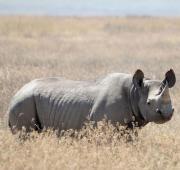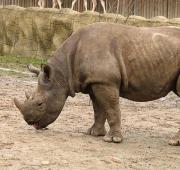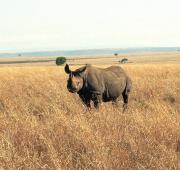 The black rhinoceros (also known as the hook-lipped rhinoceros) is a large species of rhinoceros native to Africa. Despite it's name, the black rhinoceros is actually fairly light in color with most black rhinoceros individuals having either white or gray skin.
The black rhinoceros (also known as the hook-lipped rhinoceros) is a large species of rhinoceros native to Africa. Despite it's name, the black rhinoceros is actually fairly light in color with most black rhinoceros individuals having either white or gray skin. Historically, the black rhinoceros had a vast range across central and eastern Africa in countries including Kenya, Tanzania, Cameroon, South Africa, Namibia, Zimbabwe, and Angola. Although the black rhinoceros is still found in these countries today, their numbers are very few and far between.
Historically, the black rhinoceros had a vast range across central and eastern Africa in countries including Kenya, Tanzania, Cameroon, South Africa, Namibia, Zimbabwe, and Angola. Although the black rhinoceros is still found in these countries today, their numbers are very few and far between.


The black rhinoceros is a herbivorous animal meaning that it sustains itself on a purely plant based diet. Black rhinos browse the densely vegetated savanna for leaves, flowers, buds, fruits, berries and roots which they dig up from the ground using their horns.
Due to it's large size, the black rhino's only real predator in the wild are large wild cats such as lions that will prey on the black rhino calves and weak individuals. Humans are the biggest threat to the black rhinoceros as they have been hunted to the brink of extinction for their horns.
The black rhinoceros is solitary animal and only comes together with other black rhinos to mate. The female black rhinoceros gives birth to a single calf after a gestation period that is over a year long. The black rhinoceros calf remains with it's mother until it is at least 2 years old and big enough to become independent.
Today, the black rhinoceros is a critically endangered animal said to be on the brink of extinction in the wild. There are only a handful of black rhinoceros individuals left in the wild, but reports suggest that black rhinoceros population numbers are now beginning to increase due to continued conservation efforts.

